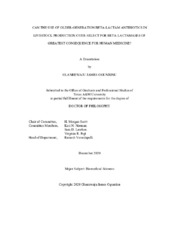| dc.description.abstract | We tested the potential and extent to which β-lactam antimicrobials already approved for use in U.S. livestock operations may differentially select for resistance to unapproved highest priority antibiotics such as carbapenems. We did this using layered in vitro experimental approaches and by a mathematical pharmacokinetic-pharmacodynamic (PK-PD) model of β-lactam selection effects on a mixture of Escherichia coli (E. coli) population in the pig large intestine. To achieve this, host-adapted E. coli strains bearing a single β-lactamase gene (n=20 each) for blaTEM-1, blaCMY-2, and blaCTX-M-* or else blaKPC/IMP/NDM (due to limited availability, often in combination with other bla genes), were identified, along with 20 E. coli strains lacking beta-lactamase genes. Individual and group intrinsic bacterial fitness, as well as growth rates of resistant strains in corresponding β-lactams (e.g., ampicillin, ceftriaxone and meropenem) were estimated. Further, to estimate the relative impact of β-lactams on strain-groups, mixed-strain (n=10, 2 representatives/group) in vitro experiments in batch cultures and dynamic anerobic porcine chemostats were performed, with and without β-lactams. Similarly, a mathematical PK-PD model of the E. coli mixture in the pig colon, with and without routine ceftiofur therapy, was assessed.
Overall, bla-free strains demonstrated a fitness advantage over bla-positive strain-groups and strain-groups with lower resistance forms appeared better adapted to anerobic porcine culture medium; however, the persistence of higher resistance forms was increased with β-lactam introduction. In the presence of a 3rd generation cephalosporin, ESBL-type strains consistently and notably out-competed the AmpC-type strains, even at relative lower starting densities. Furthermore, in experimental and modeled mixed-strain E. coli community, higher concentrations of routine use of β-lactams significantly elevated the relative proportions of carbapenemase-producing Enterobacteriaceae (CPE) in spite of their extremely low baseline composition. These findings suggest that currently approved β-lactams can increase the prevalence of newer resistance forms that are of greater public health consequence; further, it can be inferred that drug use restrictions alone may be insufficient to control the spread of CPEs in livestock and human settings. The currently extremely low prevalence levels of these strains in agriculture provides an opportunity for a proactive response rather than waiting to require a reactionary approach. | en |


